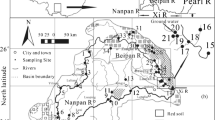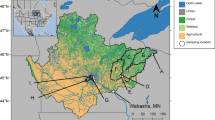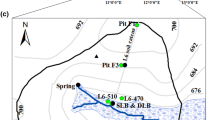Abstract
Boreal forests are thought to be an important source and sink for pyrogenic carbon, or black carbon (BC), as fire is very common in this type of ecosystem. However, the reported soil BC content in boreal forests is low, suggesting active removal processes of soil BC possibly through transfer to the dissolved phase. In this study, dissolved black carbon (DBC) concentrations from samples collected from streams in Alaska boreal forest watersheds and in glacial rivers are reported. The DBC levels, as well as its degree of polycondensation, in glacial rivers are much lower than those from boreal forest streams. This suggests source differences (fossil fuel vs. forest fires) as a possible reason for these molecular variations. Our hypothesis is that DBC in boreal forest watersheds is mostly generated from forest fires, while glacial rivers will receive a higher relative contribution of BC from atmospheric deposition, resulting in a more fossil fuel like molecular signature of DBC in the latter. To test the source hypothesis, we compared the DBC molecular characteristics of samples from boreal rives and glacier-fed streams with additional samples from locations isolated from significant fire-derived inputs, where atmospheric deposition of anthropogenic soot may be important. Based on this comparative approach, we suggest that anthropogenic BC, associated with small soot particles, is the most prominent source of DBC in the glacial rivers. A linear positive correlation between dissolved organic carbon (DOC) and DBC concentrations was observed for both boreal forest and glacial samples, once again confirming that DOC and DBC dynamics are closely coupled. The ever increasing export of DOC associated DBC from high latitude boreal forests and glaciers as a result of global warming, may impact DOC quality and ultimately trophic dynamics in the receiving marine environment.




Similar content being viewed by others
References
Alvarez-Salgado XA, Miller AEJ (1998) Simultaneous determination of dissolved organic carbon and total dissolved nitrogen in seawater by high temperature catalytic oxidation: conditions for precise shipboard measurements. Mar Chem 62(3–4):325–333
Bond TC, Doherty SJ, Fahey DW, Forster PM, Berntsen T, DeAngelo BJ, Flanner MG, Ghan S, Kärcher B, Koch D, Kinne S, Kondo Y, Quinn PK, Sarofim MC, Schultz MG, Schulz M, Venkataraman C, Zhang H, Zhang S, Bellouin N, Guttikunda SK, Hopke PK, Jacobson MZ, Kaiser JW, Klimont Z, Lohmann U, Schwarz JP, Shindell D, Storelvmo T, Warren SG, Zender CS (2013) Bounding the role of black carbon in the climate system: a scientific assessment. J Geophys Res 118(11):5380–5552
Cawley KM, Ding Y, Fourqurean J, Jaffé R (2012) Characterising the sources and fate of dissolved organic matter in Shark Bay, Australia: a preliminary study using optical properties and stable carbon isotopes. Mar Freshw Res 63(11):1098–1107
Cooke WF, Wilson JJN (1996) A global black carbon aerosol model. J Geophys Res 101(D14):19395–19409
Czimczik CI, Preston CM, Schmidt MWI, Schulze ED (2003) How surface fire in Siberian Scots pine forests affects soil organic carbon in the forest floor: stocks, molecular structure, and conversion to black carbon (charcoal). Glob Biogeochem Cycles 17(1):GB3005
Ding Y, Yamashita Y, Dodds W, Jaffé R (2013) Dissolved black carbon in grassland streams: is there an effect of recent fire history? Chemosphere 90(10):2257–2562
Ding Y, Cawley K, Cunha CN, Jaffé R (2014) Environmental dynamics of dissolved black carbon in wetlands. Biogeochemistry 119(1–3):259–273
Dittmar T (2008) The molecular level determination of black carbon in marine dissolved organic matter. Org Geochem 39(4):396–407
Dittmar T, Koch BP (2006) Thermogenic organic matter dissolved in the abyssal ocean. Mar Chem 102(3–4):208–217
Dittmar T, Koch B, Hertkorn N, Kattner G (2008) A simple and efficient method for the solid-phase extraction of dissolved organic matter (SPE-DOM) from seawater. Limnol Oceanogr Methods 6:230–235
Dittmar T, de Rezende CE, Manecki M, Niggemann J, Ovalle ARC, Stubbins A, Bernardes MC (2012a) Continuous flux of dissolved black carbon from a vanished tropical forest biome. Nat Geosci 5(9):618–622
Dittmar T, Paeng J, Gihring TM, Suryaputra IGNA, Huettel M (2012b) Discharge of dissolved black carbon from a fire-affected intertidal system. Limonol Oceanogr 57(4):1171–1181
Dolinova I, Ruzicka R, Kurkova R, Klanova J, Klan P (2006) Oxidation of aromatic and aliphatic hydrocarbons by OH radicals photochemically generated from H2O2 in ice. Environ Sci Technol 40:7668–7674
Druffel ERM (2004) Comments on the importance of black carbon in the global carbon cycle. Mar Chem 92(1–4):197–200
Fastie CL, Lloyd AH, Doak P (2003) Fire history and postfire forest development in an upland watershed of interior Alaska. J Geophys Res 108(D1):13
Glaser B, Haumaier L, Guggenberger G, Zech W (1998) Black carbon in soils: the use of benzenecarboxylic acids as specific markers. Org Geochem 29(4):811–819
Goldberg ED (1985) Black carbon in the environment: properties and distribution. Wiley, New York
Guggenberger G, Rodionov A, Shibistova O, Grabe M, Kasansky OA, Fuchs H, Mikheyeva N, Zrazhevskaya G, Flessa H (2008) Storage and mobility of black carbon in permafrost soils of the forest tundra ecotone in Northern Siberia. Glob Change Biol 14(6):1367–1381
Hammes K, Schmidt MWI, Smernik RJ, Currie LA, Ball WP, Nguyen TH, Louchouarn P, Houel S, Gustafsson O, Elmquist M, Cornelissen G, Skjemstad JO, Masiello CA, Song J, Peng P, Mitra S, Dunn JC, Hatcher PG, Hockaday WC, Smith DM, Hartkopf-Froeder C, Boehmer A, Luer B, Huebert BJ, Amelung W, Brodowski S, Huang L, Zhang W, Gschwend PM, Flores-Cervantes DX, Largeau C, Rouzaud JN, Rumpel C, Guggenberger G, Kaiser K, Rodionov A, Gonzalez-Vila FJ, Gonzalez-Perez JA, de la Rosa JM, Manning DAC, Lopez-Capel E, Ding L (2007) Comparison of quantification methods to measure fire-derived (black/elemental) carbon in soils and sediments using reference materials from soil, water, sediment and the atmosphere. Glob Biogeochem Cycles 21(3):GB3016
Harden JW, Neff JC, Sandberg DV, Turetsky MR, Ottmar R, Gleixner G, Fries TL, Manies KL (2004) Chemistry of burning the forest floor during the FROSTFIRE experimental burn, interior Alaska, 1999. Glob Biogeochem Cycles 18(3):14
Hedges JI, Eglinton G, Hatcher PG, Kirchman DL, Arnosti C, Derenne S, Evershed RP, Kogel-Knabner I, de Leeuw JW, Littke R, Michaelis W, Rullkotter J (2000) The molecularly-uncharacterized component of nonliving organic matter in natural environments. Org Geochem 31:945–958
Hinzman LD, Fukuda M, Sandberg DV, Chapin FS, Dash D (2003) FROSTFIRE: an experimental approach to predicting the climate feedbacks from the changing boreal fire regime. J Geophys Res 108(D1):6
Hinzman LD, Viereck LA, Adams PC, Romanovsky VE, Yoshikawa K (2006) Climate and permafrost dynamics of the Alaskan boreal forest. In: Chapin FS, Oswood MW, Van Cleve K, Viereck LA, Verbyla DL (eds) Alaska’s changing boreal forest. Oxford University Press, Oxford, pp 39–61
Hockaday WC, Grannas AM, Kim S, Hatcher PG (2007) The transformation and mobility of charcoal in a fire-impacted watershed. Geochim Cosmochim Acta 71(14):3432–3445
Jaffé R, Ding Y, Niggemann J, Vähätalo AV, Stubbins A, Spencer RGM, Campbell J, Dittmar T (2013) Global charcoal mobilization from soils via dissolution and riverine transport to the oceans. Science 340(6130):345–347
Jurado E, Dachs J, Duarte CM, Simo R (2008) Atmospheric deposition of organic and black carbon to the global oceans. Atmos Environ 42(34):7931–7939
Kane ES, Hockaday WC, Turetsky MR, Masiello CA, Valentine DW, Finney BP, Baldock JA (2010) Topographic controls on black carbon accumulation in Alaskan black spruce forest soils: implications for organic matter dynamics. Biogeochemistry 100(1–3):39–56
Kasischke ES, Turetsky MR (2006) Recent changes in the fire regime across the North American boreal region—spatial and temporal patterns of burning across Canada and Alaska. Geophys Res Lett 33(9):5
Kim Y, Hatsushika H, Muskett RR, Yamazaki K (2005) Possible effect of boreal wildfire soot on Arctic sea ice and Alaska glaciers. Atmos Environ 39(19):3513–3520
Masiello CA (2004) New directions in black carbon organic geochemistry. Mar Chem 92(1–4):201–213
Neff JC, Harden JW, Gleixner G (2005) Fire effects on soil organic matter content, composition, and nutrients in boreal interior Alaska. Can J For Res 35(9):2178–2187
Meybeck M (1982) Carbon, nitrogen and phodphorus transport by world rivers. Am J Sci 282:401–450
NIST (2007) Certificate of analysis, SRM 1649a urban dust. National Institute of Standards and Technology, Gaithersburg
NIST (2009) Certificate of analysis, SRM 1649b urban dust. National Institute of Standards and Technology, Gaithersburg
Ohlson M, Dahlberg B, Okland T, Brown KJ, Halvorsen R (2009) The charcoal carbon pool in boreal forest soils. Nat Geosci 2(10):692–695
Oswood MW, Hughes NF, Milner AM (2006) Running waters of the Alaskan boreal forest. In: Chapin FS III, Oswood MW, Van Cleve K, Viereck LA, Verbyla DL (eds) Alaska’s changing boreal forest. Oxford University Press, New York, pp, 147–170
Penner JE, Eddleman H, Novakov T (1993) Towards, the development of a global inventory for black carbon emissions. Atmos Environ A Gen Top 27(8):1277–1295
Preston CM, Schmidt MWI (2006) Black (pyrogenic) carbon: a synthesis of current knowledge and uncertainties with special consideration of boreal regions. Biogeosciences 3(4):397–420
Roth PJ, Lehnorff E, Brodowski S, Bornemann L, Sanchez-García L (2012) Differentiation of charcoal, soot and diagenetic carbon in soil: method comparison and perspectives. Org Geochem 46:66–75
Schneider MPW, Hilf M, Vogt UF, Schmidt MWI (2010) The benzene polycarboxylic acid (BPCA) pattern of wood pyrolyzed between 200 and 1,000 °C. Org Geochem 41(10):1082–1088
Serreze MC, Walsh JE, Chapin FS, Osterkamp T, Dyurgerov M, Romanovsky V, Oechel WC, Morison J, Zhang T, Barry RG (2000) Observational evidence of recent change in the northern high-latitude environment. Clim Change 46(1–2):159–207
Stubbins A, Hood E, Raymond PA, Aiken GR, Sleighter RL, Hernes PJ, Butman D, Hatcher PG, Striegl RG, Schuster P, Abdulla HAN, Vermilyea AW, Scott DT, Spencer RGM (2012a) Anthropogenic aerosols as a source of ancient dissolved organic matter in glaciers. Nat Geosci 5(3):198–201
Stubbins A, Niggemann J, Dittmar T (2012b) Photo-lability of deep ocean dissolved black carbon. Biogeosciences 9:1661–1670
Wada T, Chikita KA, Kim Y, Kudo I (2011) Glacial effects on discharge and sediment load in the Subarctic Tanana river basin, Alaska. Arct Antarct Alp Res 43(4):632–648
Whitehead PG, Wilby RL, Battarbee RW, Kernan M, Wade AJ (2009) A review of the potential impacts of climate change on surface water quality. Hydrol Sci J 54(1):101–123
Wozniak AS, Bauer JE, Sleighter RL, Dickhut RM, Hatcher PG (2008) Thechnical note: molecular characterization of aerosol-derived water soluble organic carbon using ultrahigh resolution electrospray ionization Fourier transform ion cyclotron resonance mass spectrametry. Atmos Chem Phys 8(17):5099–5111
Ziolkowski LA, Druffel ERM (2010) Aged black carbon identified in marine dissolved organic carbon. Geophys Res Lett 37(16). doi:10.1029/2010GL043963
Acknowledgments
This work was funded through the National Science Foundation as a supplement to the FCE-LTER (DBI-0620409) and through the BNZ-LTER program. YD thanks the FIU graduate school for a doctoral evidence acquisition (DEA) fellowship. The authors thank D. McKnight for helpful comments on the original manuscript, N. Jaffé for assistance with field sample collection, and A. Balser for generating the sampling map. Additional support for this project was provided through the George Barley Endowment to RJ. This is SERC contribution 697.
Author information
Authors and Affiliations
Corresponding author
Additional information
Responsible Editor: J.M. Melack.
Rights and permissions
About this article
Cite this article
Ding, Y., Yamashita, Y., Jones, J. et al. Dissolved black carbon in boreal forest and glacial rivers of central Alaska: assessment of biomass burning versus anthropogenic sources. Biogeochemistry 123, 15–25 (2015). https://doi.org/10.1007/s10533-014-0050-7
Received:
Accepted:
Published:
Issue Date:
DOI: https://doi.org/10.1007/s10533-014-0050-7




